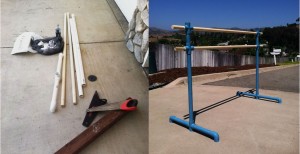This past year, I’ve had occasion to do a lot of travel. Most of it has been business, some has been personal, and all of it has presented me with a challenge if I want to practice ballet. A handy chair or railing can substitute for a barre, but you probably don’t want to do grand jetes in the hotel corridors.
Here are a few solutions I’ve found to the “Where can I dance?” problem:
1. Local Dance Studio: If you have transportation, Google the area ahead of time. Don’t be discouraged if the only thing you can find is a studio that requires students to sign up in semester-long blocks of classes. Sometimes you can get permission to join a class on a drop-in basis.
2. Local Gym: Some memberships give you access to facilities in other cities, and most gyms offer day passes. Even if a gym doesn’t have a dance studio, you can often make use of a fitness room when there isn’t a class. If you want something more private, consider appropriating a racquetball court. Gyms often have several of these and they make great private spaces for floor work.
3. Hotel: This one is hit and miss, but here are a few things to try:
• Your Room: If you are in a suite, you may be able to move the sitting room furniture out of the way and dance in the privacy of your own room.
• Pools and Exercise Rooms: Some hotels have a separate area of the fitness center for yoga and aerobics classes. Be sure to also check out the pool. Many hotels have a poolside area for small functions. You should not dance on bare concrete, but a thin carpet with low nap will often work just fine.
• Ballrooms/Conference Rooms: Sometimes you can find an unlocked door to a ballroom or conference room. If it hasn’t been set up with too many tables and chairs, you’ve got yourself a dance studio. If all the rooms are locked, explain your situation to the front desk. They have heard stranger requests than yours and may be happy to help.
A Few Considerations:
1. Scheduling: If you are angling for an empty conference room, your best chance of success will be weekday evenings and weekend mornings, so plan accordingly. This may mean skipping the drinks and heavy hors d’oeuvres at a conference reception, or skipping a reception altogether and meeting a few colleagues for dinner and drinks after your dance practice.
2. Music: If you don’t like dancing while wearing earbuds, consider buying a speaker for your mp3 player. I use the iHome 3.5 mm portable speaker, but there are many options out there.
3. Shoes: Unless you have made arrangements to attend a ballet class, leave the pointe shoes at home. You don’t know what kind of floor surface you’ll be on, and you don’t want to spend your vacation or conference covered in bruises and nursing a sprained ankle. Bring several different types of ballet slippers if you can. The shoes that are your go-to at home might be too slippery or too grabby for the dance space you find. You might even have to dance barefoot or in socks.
In sum, dance practice is very doable while away from home, but requires creativity and flexibility. Luckily, this is what ballet is all about. Just remember to get outside and see a few sights while you’re away, too. Have a few adventures, because when you get home the last thing your non-ballerina friends will want to hear about is your perfect pirouette by the hotel pool.








